KSIA Keswick
(c) Antique Metalware Society
Small extracts can be used with acknowledgements to 'Oldcopper.org' website.
Helpful comments are very welcome.
Keswick School of Industrial Art
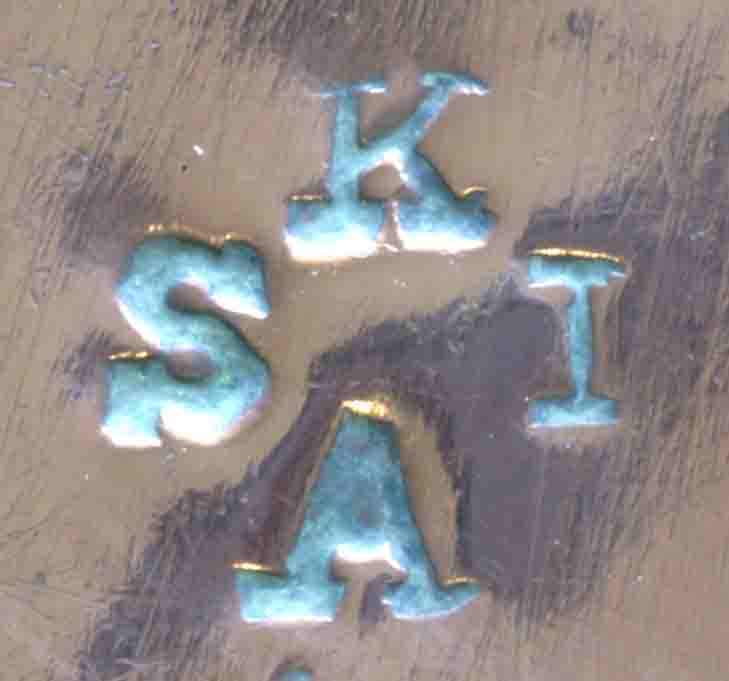 KSIA, Keswick School of Industrial Art, Lake District, founded in 1884 by Canon and Mrs Rawnsley. Copper had been mined for many years nearby in the Lake District but operations had declined by the time the School was founded; supplies of copper sheet were obtained commercially. The third mark commemorated Queen Victoria’s Jubilee.
KSIA, Keswick School of Industrial Art, Lake District, founded in 1884 by Canon and Mrs Rawnsley. Copper had been mined for many years nearby in the Lake District but operations had declined by the time the School was founded; supplies of copper sheet were obtained commercially. The third mark commemorated Queen Victoria’s Jubilee.
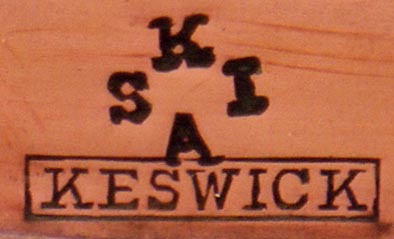
This has 'Keswick' in full as well as the 'KSIA' mark.
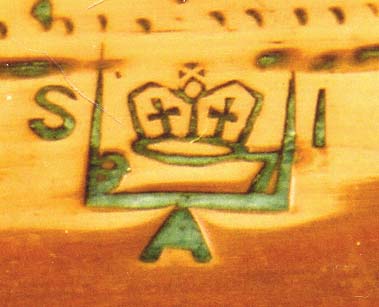 Mark used to commemorate the Jubilee of Queen Victoria.
Mark used to commemorate the Jubilee of Queen Victoria.
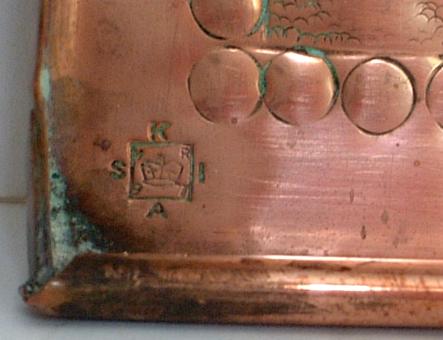
The marks are usually on the top surface of items.
 The name of W H Mawson inscribed on the face of an engraved small brass tray.
The name of W H Mawson inscribed on the face of an engraved small brass tray.
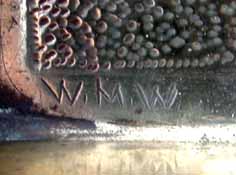
W,H.W. crafstman mark.
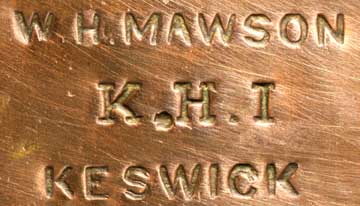
Keswick Home Industries was set up by W H Mawson after he left KSIA.
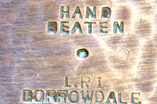
Lakeland Rural Industries, Borrowdale, Lake District, simple flat and hollow copperware from near the Keswick area, made during the mid 20th century. Stamped ‘LRI Borrowdale’
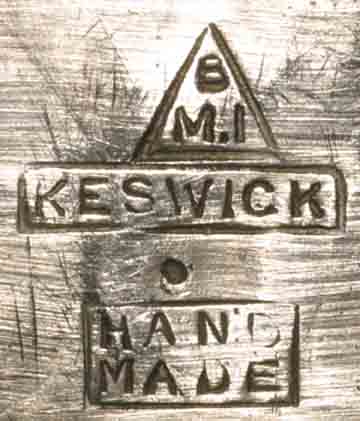
'B M I' Keswick. Mark on a simple plated copper dish, further information welcome.
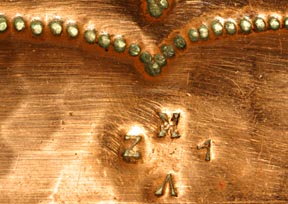
Imitation 'ksia' mark stamped under a shield purporting to be that of King Henri IV of France in a light copper tray of Turkish style of coppercraft. It has a decoration of fleur-de-lys in each corner pin punched into place. The handles are cheaply cast brass.
Thomas Sparks from KSIA went across to the Youghal Works in Ireland in 1904 to give his specialist skills to the workers. This is why much of the output from Youghal is based on ksia construction. Hence unmarked 'Keswick' is quite often unmarked 'Youghall' unless you know the specific differences' (Brian of Price Walker ltd, Keswick)
Keswick
Text compiled by Philip Crouch and Jamie Barnes with acknowledgements to ‘The Loving Eye and Skilful Hand: The Keswick School of Industrial Art’, Ian Bruce, 2001
Canon Rawnsley, champion of the Lake District and founder of the National Trust set up the school. From 1883 he was vicar of St Kentigem's Church, Crosthwaite, just outside Keswick.
Rawnsley was a good friend of John Ruskin, whose art and writings laid the foundation of the Arts and Crafts movement. This movement developed in the middle of the nineteenth century, with a growing resistance in some parts of Victorian society to industrialisation. Ideas of `truth to nature' and honest craftsmanship fed into the founding of the Keswick School.
Classes for metalwork were initially held in the Crosthwaite church parish rooms and soon developed to offer classes in drawing, design, and woodcarving. Soon the need for separate premises became apparent and a grant from the County Council and several private donations led to the construction of the School building in 1893. This building still stands on High Hill and is currently home to the Italian restaurant `Lucas'.
The School prospered and swiftly developed a reputation for high quality copper and silver decorative metalwork. By 1890 the School was exhibiting nationally and winning prizes. Special commissions began to arrive from regional and national customers. In the following decades the School, managed by a committee of Trustees, evolved into a commercial metalwork enterprise. This evolution included the adoption of stainless steel as a material in the 1930's, and the use of machinery from the 1960's.
The school closed in 1984, having faced increasing pressure from imported goods for a number of years.
EARLY YEARS, AND THE BUILDING OF THE SCHOOL
Rawnsley described the atmosphere in the school in the early years:
"It is a sight that does one's heart good to see that Parish-room on a "School" night. The workers are so intent, so critical, so cheery. A finished bit of work comes in. It is a tea-tray in brass, or an offertory dish in gilding metal;... .It may be a little silver menu-holder, whose design has come from the Venetian binding of a middle-century book. Whatever it is, the hammers cease going, and one by one the men crowd up and examine it, and every one has something to say about it except the worker, and he just listens and smiles, and goes on with the work in front of him."
The new School building was opened in 1894, the design echoing traditional Lakeland methods of construction, using local slate for the walls and the roof and gables made of Borrowdale Volcanic stone. The spinning-galleries of vernacular Lakeland barns and houses provided inspiration for a gallery which was built at the first floor with four arched bays. The external steps gave access to the showroom where the work of the School was displayed.
A particular feature of the new building was a collection of all objects and models, which constituted a reference collection for the workers. There was also a library, the latter containing some work given by William Morris.
The early years of the school saw a list of rules established which carried on well into the modern period. The aims of the KSIA were stated as such:
- To counteract the pernicious effects of turning men into machines without the possibility of love for their work.
- To make it felt that hand-work really does allow expression of a man's soul and self, and so is worth doing for it's own sake, and worth purchasing even at some cost to the buyer.
- To try to displace by hand-work the crude metal and wooden ornaments produced by steel dies and hydraulic presses.
- To show that here in England an abundance of skill of hand is wasted which, if any education worth its name were given to the whole working man - to his eye, hand, heart, as well as head - could and would help England.
1898-1930
The early work of the School was influenced by the Celtic and Norse heritage of the Lake District and the ideas of the Renaissance. By the end of the nineteenth century however, the Arts and Crafts movement began to have an influence over the School. The School reflected the ideals of the Arts and Crafts movement with its focus on 'truth to nature' and hand crafted work. The grounds of the School were planted with flowers, trees and shrubs to ensure that observation from nature would influence design. The School went on to produce some fine work in the Arts and Crafts style.
Throughout the life of the School, traditional pieces were still made from the original design sources. New designs however, did reflect the artistic fashions of the period. As the new century got under way, the popularity of Arts and Crafts style declined and gave over to Art Nouveau. The two styles cross over in Herbert J Maryon's memorial to Bernard Gilpin, executed at the school in 1901. This new style is even more pronounced a few years later in 1904, when Robert Hilton is appointed Director.
Production records give a picture of a thriving industry in the years up to the war. The outbreak of the First World War brought dramatic changes as the craftsmen enlisted, and hardship reduced the demand. In these difficult circumstances the School existed by filling a need for memorial plaques and crosses.
After the war George Atholl Weeks was appointed Director and, together with Eleanor Rawnsley, set out to re-invigorate the School. Repousée work, which was labour intensive and unfashionable, struggled to find a market. In 1923, after a campaign of advertising and exhibitions of the work of the School, interest was again gaining ground. Atholl Weeks was a good manager and found new markets for the School's work. In 1925 he married the daughter of G.D. Abraham, Alpine and Lakeland climber, author and photographer. She opened shop, "The New Enterprise" in Lake Road, which retailed the work of the school. Total sales for 1925 were higher than in any year since 1913.
1931-1984
1931 saw a change in the work of the School with the introduction of stainless steel. Atholl Weeks was responsible for this, and by 1933 stainless steel accounted for half the sales from the School.
The outbreak of war in 1939 had a considerable impact on the School. Many left to assist in the war effort. Robert Pattinson went to the RAF maintenance unit at Silloth, Albert Atkinson to the Border Regiment and Ronald Wise to the Royal Engineers. John Robinson went to work in munitions at the Workington Iron and Steel works and Thomas Hartley and Ernest Harrison as instructors at the government training centre at Aintree.
During the war years Matthew Armstrong continued the limited production of the School assisted by the apprentice Richard Fisher who was called up for military service in 1943 and Withington, an apprentice, was engaged for a period until October, 1944.
In his final year with the school, 1951, Atholl Weeks submitted designs for the badge of office for the Chairman of the Keswick Urban District Council. The design for the chain to be executed in gold, incorporated enamel panels depicting Bassenthwaite Lake and the Moot Hall in Keswick Market Square. Weeks left Keswick and the chain of office was made by Thomas Hartley, who was appointed to manage the School.
In 1955, on the advice of the RCA, the School appointed Arthur Guise as a designer, who was a student at the Royal College. The School used Guise's new designs until he left in 1957. The instruction of evening classes and supervision of apprentices was then taken on by Ronnie Wise.
In 1962, Charles Petrie was made director. In 1963, having resisted the introduction of machinery for so long, the Trustees were persuaded to introduce a machine press. At the same time, the School changed its name to Keswick Industrial Arts and the evening classes were dropped. The School invested in more machines to speed production and this helped ease the financial crisis, which was brought on by competition from imported stainless steel goods. Within this difficult latter period however, exceptional pieces were still being produced.
In the centenary year of the School an exhibition and an appeal was launched. This was not enough to save the School and it was closed December of 1984, after exactly 100 years of existence.
METALS USED AT THE SCHOOL
The Keswick School of Industrial Arts was principally known for its metalwork, and the four main metals used were copper, brass, stainless steel and silver.
Copper
Copper was one of the first metals known to humans and has been used for more than 7,000 years. Copper is a soft, reddish metal that is easily worked. It is softer than iron but harder than zinc and can be polished to a bright finish.
At Keswick in the sixteenth century there was a German band of copper miners who turned their hand to making copper wares. Rawnsley liked to link these Elizabethan craftsmen to the work of the School, three hundred years later.
Brass
Brass is an alloy of copper. It is a mixture of about 70% copper and 30% zinc. In its natural state it is typically light yellow/gold in appearance. It can be cast into solid shapes, rolled into thin sheets, spun into vessel shapes or drawn into wire.
In the school, brass items were mainly decorated by `chasing' designs into them using a thin metal tool. Often the design was also punched out from the back using a technique known as repousée (see Techniques).
Stainless Steel
The type of stainless steel used by the School had the trade name `STAYBRITE'. It is a steel alloy that contains 12% chromium and is a difficult material to work with. It is much more resilient the brass or copper; it tends to spring and fight back and is less accommodating to surface decoration. The then Director, George Atholl Weeks, introduced the new material to the school in 1931. By 1933, stainless steel accounted for half the sales in the business and the School recovered from the slump it had experienced in this period. Stainless steel goods were a main part of the business right up until its closure in 1984.
Silver
Silver used in metalwork is usually alloyed with small amounts of other metals to make it more durable. Silver pieces made at the school were mainly special commissions such as church-ware or presentation gifts.
IDENTIFICATION AND MARKS
The School mark
It is difficult to be certain when the stamped school mark was introduced. The panels in Crosthwaite Church were completed by 1889 and have the letters KSIA arranged in a circle, which became the common mark of the school. Canon Rawnsley in 1902 refers to his wife "noting and criticising each piece of work, and deciding if it shall be passed and have the school stamp - a lozenge with the initials KS.I.A. upon it".
Job numbers
The first surviving record of a job number is 5830, a job which was completed on 17 November 1903. This sequence of numbers finishes on 05 May 1905 when job No.9999 is used and jobs are again numbered in sequence from 01 until November 1905.
From November 1905 letters of the alphabet were used in front of job numbers. The letter A was introduced in November 1905 and used until the last day of October 1906. From this point the next letter of the alphabet is used from the calendar year running from November to October. The jobs are also numbered in sequence from number one. This format was followed until the School's closure in 1984. The alphabet started again in 1930, 1956 and 1981 and finished with the letter C in 1983.
Queen Victoria's Diamond Jubilee
For the Jubilee in 1897, a special mark was introduced. A crown set in a square with V R in the top corners. The bottom corners contained a 97 and were bounded by the letters KSIA.
Students work
From the early years of the School, both full time craftsmen and students at evening classes made work. New rules in 1923 did not allow the work of the evening classes to be marked with the K.S.I.A. stamp. Evening classes were a feature of the School and are probably the source of much of the unmarked work that is found.
Stainless steel
A change in the marks comes with the introduction of stainless steel in 1931. Steel is a hard metal. It is likely that the dies, which had been used on softer metals like copper, did not make marks on steel. The word KESWICK and FIRTH STAYBRITE are now seen in the mark. A smaller version of the word KESWICK set in a rectangle was also included on silver articles together with the School mark and hallmark.
Additional marks
The full name of the School is often marked on large memorials and two further marks can be found on works from the 1930's onwards: KESWICK: SCH OF INDUST ARTS and K/SI/A.
1984 December: The School is closed.
Text compiled by Philip Crouch and Jamie Barnes
With acknowledgements to ‘The Loving Eye and Skilful Hand: The Keswick School of Industrial Art’, Ian Bruce, 2001